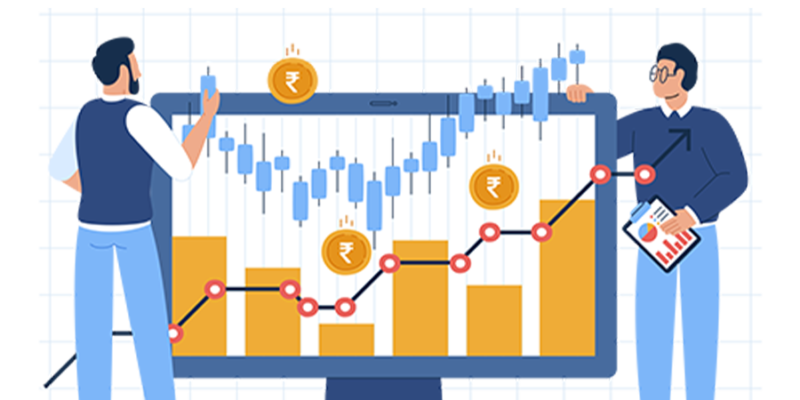
Nifty 50 is the main index of the NSE stock exchange and represents the market value of top listed companies in India from various sectors and industries. You can buy and sell stocks or trade-in in futures & options contract of selected stocks, as designated by the stock exchange.
Apart from individual stocks, the futures of a few broader market indices like Nifty50 Future or Bank Nifty Future and newly introduced Nifty next 50 contract are also traded on the stock exchange, providing trading opportunities to traders with the significant rise or fall in the spot price of the Nifty 50 index. Hence, in this article, we are going to discuss about Nifty Futures, its lot size, margins required and how to trade etc.
How Nifty Futures Work?
Nifty future contracts are traded on the stock exchange with certain rules and regulations. There is a specific lot size and expiry date of each contract for the Nifty future that you can buy or sell through your trading account. In Nifty Future trading you can buy in the lot size and multiple of that, before the date of expiry date of Nifty Future you have to square off your trade position.
At the time of buying or selling the Nifty Future contract, you should keep various things in mind like checking the volatility index of the Nifty Future and the time horizon of the contract expiry date. However, to better understand how Nifty Future works let’s take an example discussed below.
Let’s assume the Nifty future is trading at around 22000 levels and suppose, you think the Nifty index will go up in by the end of the month (before the future contract expiry date). Here you can buy the Nifty Future with the margin placed at a small percentage of the contract’s cost.
The minimum lot size of a Nifty future contract is 25, and you can buy or sell in lots and their multiples. And if you buy 1 lot (25 shares), then you have to pay a certain margin, not the whole amount and as per the price movement on a daily basis you have to maintain the margins
Here if your speculation is right and the Nifty future moves from 22000 levels to 22500 by the end of the date of Nifty future expiry date, then you can sell your 25 quantity of Nifty future and can earn a profit of Rs 12,500 {(22500-22000) X 25} through buying and selling of the Nifty future contract. However, if the Nifty future goes down from 22000 levels, then you will incur the loss.
What is the Lot & Contract Size of Nifty Futures?
The lot size of the Nifty future is determined by the exchange and from time to time it keeps changing as per the increase and decrease in the value of the Nifty future. Currently, the lot size of Nifty Fut. is 25 and you can further buy or sell in the multiple of that.
On the other hand, the value of the futures contracts on Nifty 50 may not be less than Rs. 5 lakhs at the time of introduction. The permitted lot size for futures contracts shall be the same for a given underlying or such lot size as may be stipulated by the Exchange from time to time.
And at the time of trade as per the current value of Nifty and multiplying the same with lot size you have to deposit certain margins that will be adjusted at the time of date of expiry. However, meanwhile, there are certain types of margins like SPAN margin and exposure margin required.
How Much Margin is Required for Nifty Futures?
The value of the Nifty future keeps fluctuation as there is volatility in the market that can lead to unlimited profits and losses on both sides for the trades. To cover the difference between the trade price and the unexpected moved price, the exchange has created the margins that you have to maintain while trading in the Nifty future or in the F&O segment.
At the time of entering into a Nifty future contract, at the start, you have to pay an initial margin that includes the VAR margin and the ELM margins. As per the instructions from the stock exchange, all the brokers have to collect both these margins. On the other hand, on a daily basis, you have to pay MTM (mark to market) margins based on the movement in the Nifty future price.
Calculating the margin is complicated and time-consuming process, as there are various parameters considered while calculating margin. Suppose you want to trade Nifty Future, the market price of Nifty Future is 22000 and the quantity is 50. You have to deposit the SPAN margin for the Nifty Future with exchange, which is 10% of the total contract value.
In calculation, the total contract value is 50 x 22000 = 11, 00, 000. Spam margin is 10% of 11, 00, 000, i.e. 1, 10, 000, so you have to pay Rs 1, 10 ,000 as the span margin to trade in the Nifty future.
As the Nifty future is the expected future price of the Nifty index, hence it can trade either at a premium or discount as per the market condition and sentiments of the investors or traders.
Why Nifty Futures Trades at Premium?
When the price of the Nifty Future is trading higher than the spot price, then it is said the natural order of things, and Nifty Future is trading at a premium. In the equity market it is called premium, while in the commodity market when the future price is higher than the spot, it is called “Contango”.
When investors or traders are bullish and expect in the coming days, the Nifty price will go up, then the future contracts of Nifty trade at a premium. And because of such expectations and positive sentiments among the traders and investors the Nifty Future price trades at a premium.
Why Nifty Futures Trades at a Discount?
When the Nifty future price trades at a lower price compared to the spot price then, it is called Nifty futures at a discount. In the commodity derivatives market when underlying assets future trade at a discount it is called backwardation, while in the equity market, it is called the discount.
When investors or traders speculate that in the upcoming days, the Nifty will go down and trade at lower levels compared to its current levels, then future contracts of Nifty trades at the discounted price. In another situation, the futures contracts don’t earn dividends, hence dividends lead to futures quoting at a discount. And there are also implications of brokerage and statutory costs.
Advantages of Trading in Nifty Futures
Trading in the main index comes with various benefits, in fact, trading in future and options is beneficial in various terms compared to the cash market. One of the best advantages of trading in Nifty future is you don’t need to take the delivery of assets, to hold that you need a demat account. However, there are several benefits of trading in the Nifty future that you can see below.
Limit Downside Risk
The market usually keeps moving in the upward direction, though it keeps correcting or comes down on various trading sessions but not more than 10% to 15% in extreme macro-economic factors that can affect the sentiments of the investors.
No Risk of Default
Another advantage of trading in the Nifty future is that contract buyers and sellers both are ensured to get the final settlement that is guaranteed by the stock exchange and clearing corporation. If any of them default, then the exchange takes the responsibility to settle.
Trade to Buy or Sell
You can buy or sell any stock from cash market if underlying has enough liquidity to meet the demand and supply factor. For selling or short-selling you must have the physical delivery of stocks or you can borrow the underlying from anyone and then sell in market. While in Nifty future you create the long as well as short positions without having any physical delivery of the index. Hence, in the Nifty future, you can buy or sell and square off your position before the date of expiry.
Low Margins Required
In Nifty Future, you can trade in a number of quantity of shares with lower margins. In a cash market, you have to pay the entire amount of the total quantity multiplied by the market price. In the future market, you just need to deposit only a few portions of the total value and you can enjoy the profit as per the total value that will be settled on the expiry day.
Consolidated Outlook
Trading in individual underlying security means you have a positive or negative view of that particular stock. It could be risky to predict the movement of individual stock. While trading in the main index you have a view of the entire market considering the macroeconomic factors. It is benefits of trading in N.ifty future that avoids the micro risk of stocks.
Things to Consider While Trading in Nifty Futures
While trading in the broader market index you can enjoy multiple benefits that you might miss trading in the cash market. As we all know benefits come with risks and there are few things that you need to consider while trading in the N.ifty future or any other underlying security of index trading on the exchange.
Understanding the Basics
Before you start you journey as a trader, you need to be 100% clear with practical application of basics of the derivatives market like what are contracts, expiry date, how margin amount affected with change in expiry, implied volatility, etc. It will clear your concepts and make it easier to make quick decisions while trading in future markets.
Trade with Leveraged Position:
Trading in the N.ifty Futures comes with a leveraged position. This means you can enjoy the profits multiple times due to the availability of high margins for trade. For intraday, you can get up to 5% margins while for futures trading you can get up to 10% margins that give your trade positions highly leveraged and can give you multiple times profits as well as losses.
Check the Open Interest Data
In the futures and options market, open interest (OI) plays a very important role, hence while trading in the N.ifty future you have to closely watch the OI data that will help you to know the trend or sentiments of traders towards the future index. The increase or decrease in OI with price change gives insights into the future index to make the right decision.
Evaluate the Spread over the Spot
Before you execute any N.ifty future contract, always check the difference between the spot and future price of the underlying. If there is a big difference in the spot and future price of the underlying, or trading at too much premium or discount there could be aggressive buying or selling. The minor difference in spot and futures prices is common but not too much.
Always Trade with Stop Loss
Trading in the future market is like intraday or short-term trading, as you have to exit from your trade position which could cost you in terms of loss. Hence, you need to be very careful and use preventive techniques like stop loss while trading in the futures & options. Use the stop loss while creating long or short position Nifty futures to avoid major losses.
How to Trade in Nifty Futures?
In order to trade a Nifty derivative contract or any other security derivative contract you need to open a trading account with the discount broker or full-service broker, which have your E-kyc updated to become eligible to trade in the F&O market. But you need to be very careful while trading in the indices F&O contract as volume comes with high volatility and premium decay making it difficult to trade for beginners.









